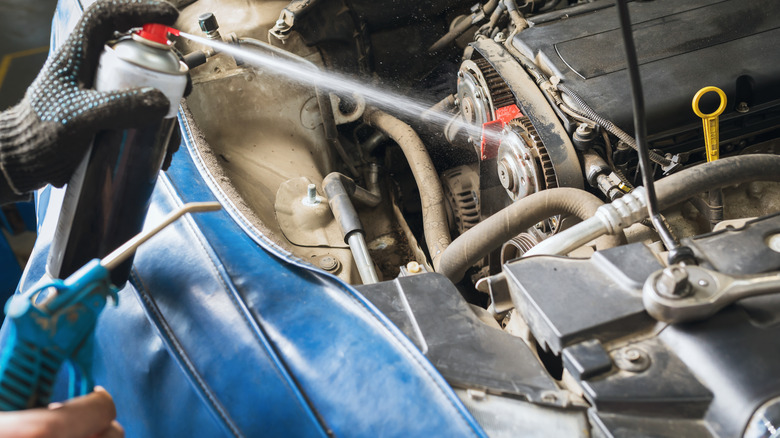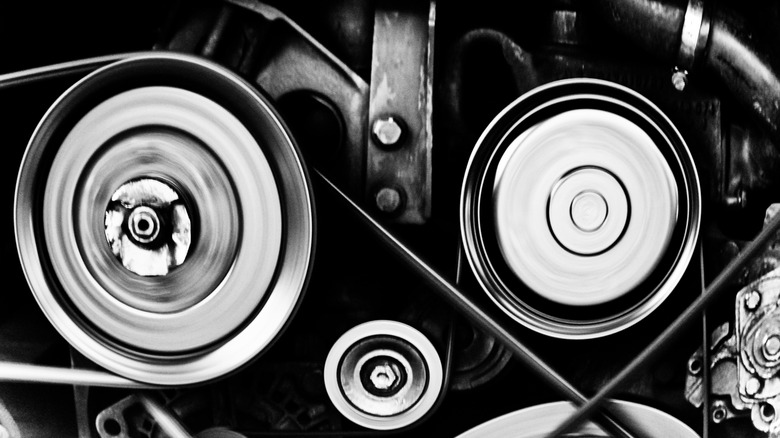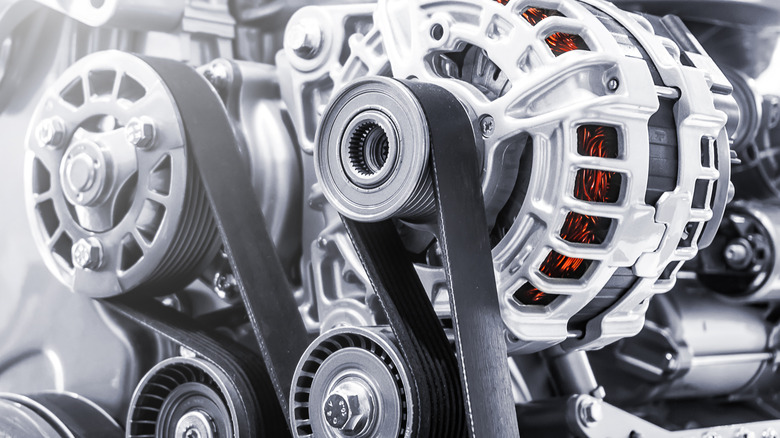Is It Safe To Use WD-40 On A Squeaky Engine Belt?
It's somewhat common to hear a loud squeal from under the hood of your car, even if it's in otherwise good running order. That high-pitched sound is annoying, and could signal potentially expensive repairs down the road. A quick Google search might lead you to a cheap, easy solution for squeaky machinery: WD-40. While there are plenty of unexpected uses for WD-40, "eliminates squeaks" is one of its listed on-label purposes. But although it has plenty of uses in your home, car, and workshop, there are a few places you should never use WD-40, including on the belts of your car's engine.
Engine belts are not meant to be lubricated. In fact, spraying WD-40 on a squeaky belt can cause more problems than it solves; and while the squeak might stop for a little while, it doesn't mean the underlying issue is gone. The noise can come back louder than ever, or important engine accessories like the water pump, alternator, or power steering pump might stop working properly.
Why WD-40 is bad for your engine belts
The biggest problem with spraying WD-40 on an engine accessory belt is that it reduces friction, which is critical to the proper functioning of the belts and components on the front of your engine. These belts transfer rotational energy by gripping pulleys with precise tension. Making them slippery with WD-40 or other lubricants reduces the friction between the belt and the pulley and is essentially the same as driving with loose belts. Lubricated belts can slip on the pulleys, meaning your engine accessories won't be working as efficiently as they need to.
There's also a risk to the structural integrity of the rubber in the belts, as WD-40 contains chemicals that will break the material down over time. So although the belt may look shiny and new after a quick spritz, exposure to WD-40 will cause it to crack or otherwise fail sooner than it should. It's similar to the reason why you should never spray WD-40 on your brake pads and rotors — although it might make the noise go away briefly, it's damaging and potentially dangerous in the long run. Long story short: belts are made to run dry, not slick.
What to do if your engine belts are squeaking
If your belt is squeaky, that's because it's probably worn, improperly tensioned, or misaligned. Spraying a lubricant on it doesn't solve the root cause, though. The smart move is to inspect your belt or belts for wear, cracks, and proper adjustment. You should also stand to one side of the car and check the alignment of the pulleys as the engine runs, making sure to keep fingers and hair clear of any moving parts. Also check the tension on each belt, especially on cars that don't have automatic tensioners becausea belt that's too tight can make an engine accessory or tensioner's bearings squeal as it turns. A properly tensioned belt will deflect about a half inch at its longest point between two pulleys when you push on it with your finger.
If you're still tempted to spray something to quiet your noisy belts, at least use the right product. WD-40 makes a belt dressing designed specifically for this job. It's specially formulated to soak into the fibers of the belt to restore flexibility and life to old rubber. But even so, it's important to find out why the belt is squealing and fix the problem before you end up stranded on the side of the road with a dead alternator or water pump. The bottom line is that you should never use WD-40 on a squeaky engine belt, and be very careful with the flammable spray near sources of heat, spark or open flame.


